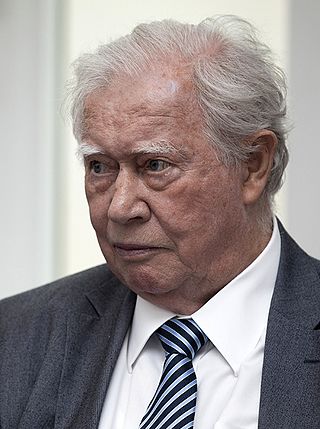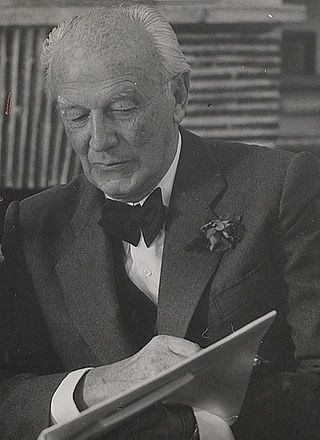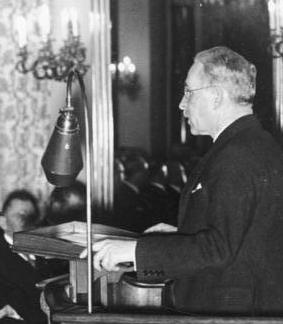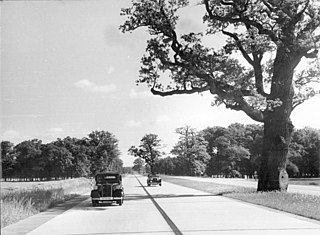
Berthold Konrad Hermann Albert Speer was a German architect who served as the Minister of Armaments and War Production in Nazi Germany during most of World War II. A close ally of Adolf Hitler, he was convicted at the Nuremberg trials and sentenced to 20 years in prison.

The Hitler Youth was the youth organisation of the Nazi Party in Germany. Its origins date back to 1922 and it received the name Hitler-Jugend, Bund deutscher Arbeiterjugend in July 1926. From 1936 until 1945, it was the sole official boys' youth organisation in Germany and it was partially a paramilitary organisation. It was composed of the Hitler Youth proper for male youths aged 14 to 18, and the German Youngsters in the Hitler Youth for younger boys aged 10 to 14.

Organisation Todt was a civil and military engineering organisation in Nazi Germany from 1933 to 1945, named for its founder, Fritz Todt, an engineer and senior member of the Nazi Party. The organisation was responsible for a huge range of engineering projects both in Nazi Germany and in occupied territories from France to the Soviet Union during the Second World War. The organisation became notorious for using forced labour. From 1943 until 1945 during the late phase of the Third Reich, OT administered all constructions of concentration camps to supply forced labour to industry.

Fritz Todt was a German construction engineer and senior figure of the Nazi Party. He was the founder of Organisation Todt (OT), a military-engineering organisation that supplied German industry with forced labour, and served as Reich Minister for Armaments and Ammunition in Nazi Germany early in World War II, directing the entire German wartime military economy from that position.
Mischling was a pejorative legal term which was used in Nazi Germany to denote persons of mixed "Aryan" and "non-Aryan", such as Jewish, ancestry as they were classified by the Nuremberg racial laws of 1935. In German, the word has the general denotation of 'hybrid', 'mongrel', or 'half-breed'. Outside its use in official Nazi terminology, the term Mischlingskinder was later used to refer to war babies born to non-white soldiers and German mothers in the aftermath of World War II.

Hans Mommsen was a German historian, known for his studies in German social history, for his functionalist interpretation of the Third Reich, and especially for arguing that Adolf Hitler was a weak dictator. Descended from Nobel Prize-winning historian Theodor Mommsen, he was a member of the Social Democratic Party of Germany.

The National Socialist Motor Corps was a paramilitary organization of the Nazi Party (NSDAP) that officially existed from May 1931 to 1945. The group was a successor organisation to the older National Socialist Automobile Corps, which had existed since April 1930.

Paul Bonatz was a German architect, member of the Stuttgart School and professor at the technical university in that city during part of World War II, and from 1954 until his death. He worked in many styles, but most often in a simplified neo-Romanesque, and designed important public buildings both in the Weimar Republic and under the Third Reich, including major bridges for the new autobahns. In 1943 he designed several buildings in Turkey, returning to Stuttgart in 1954.

Ba was an ancient state in eastern Sichuan, China. Its original capital was Yicheng, Hubei. Ba was conquered by Qin in 316 BC. The historical Bo people and the modern Tujia people trace some of their origins back to the people of Ba.

Shu, also known as Ancient Shu in historiography, was an ancient kingdom in what is now Sichuan Province. It was based on the Chengdu Plain, in the western Sichuan basin with some extension northeast to the upper Han River valley. To the east was the Ba tribal confederation. Further east down the Han and Yangtze rivers was the State of Chu. To the north over the Qinling Mountains was the State of Qin. To the west and south were tribal peoples of little military power.

Peter Paul Freiherr von Eltz-Rübenach was Reich Postal Minister (Reichspostminister) and Reich Minister of Transport (Reichsminister für Verkehr) of Germany between 1932 and 1937.

The use of slave and forced labour in Nazi Germany and throughout German-occupied Europe during World War II took place on an unprecedented scale. It was a vital part of the German economic exploitation of conquered territories. It also contributed to the mass extermination of populations in occupied Europe. The Germans abducted approximately 12 million people from almost twenty European countries; about two thirds came from Central Europe and Eastern Europe. Many workers died as a result of their living conditions – extreme mistreatment, severe malnutrition and abuse were the main causes of death. Many more became civilian casualties from enemy (Allied) bombing and shelling of their workplaces throughout the war. At the peak of the program the forced labourers constituted 20% of the German work force. Counting deaths and turnover, about 15 million men and women were forced labourers at one point during the war.

Joseph Wulf was a German-Polish Jewish historian. A survivor of the Auschwitz concentration camp, he was the author of several books about Nazi Germany and the Holocaust, including Das Dritte Reich und die Juden ; Heinrich Himmler (1960); and Martin Bormann: Hitlers Schatten (1962). The House of the Wannsee Conference museum in Berlin houses the Joseph Wulf Library in his honour.

Franz Xaver Dorsch was a German civil engineer who became the chief engineer of the Organisation Todt (OT), a civil and military engineering group in Nazi Germany that was responsible for a huge range of engineering projects at home and in the territories occupied by the Germans during the Second World War. He played a leading role in many of the Third Reich's biggest engineering projects, including the construction of the Siegfried Line (Westwall), the Atlantic Wall and numerous other fortifications in Germany and occupied Europe. Following the war, he founded the Dorsch Consult consulting engineering company in Wiesbaden.

The Reichsautobahn system was the beginning of the German autobahns under Nazi Germany. There had been previous plans for controlled-access highways in Germany under the Weimar Republic, and two had been constructed, but work had yet to start on long-distance highways. After previously opposing plans for a highway network, the Nazis embraced them after coming to power and presented the project as Hitler's own idea. They were termed "Adolf Hitler's roads" and presented as a major contribution to the reduction of unemployment. Other reasons for the project included enabling Germans to explore and appreciate their country, and there was a strong aesthetic element to the execution of the project under the Third Reich; military applications, although to a lesser extent than has often been thought; a permanent monument to the Third Reich, often compared to the pyramids; and general promotion of motoring as a modernization that in itself had military applications.

This is a list of books about Nazi Germany, the state that existed in Germany during the period from 1933 to 1945, when its government was controlled by Adolf Hitler and his National Socialist German Workers' Party. It also includes some important works on the development of Nazi imperial ideology, totalitarianism, German society during the era, the formation of anti-Semitic racial policies, the post-war ramifications of Nazism, along with various conceptual interpretations of the Third Reich.

The Mangfall Bridge is a motorway bridge across the valley of the Mangfall north of Weyarn in Upper Bavaria, Germany, which carries Bundesautobahn 8 between Munich and Rosenheim. The original bridge, designed by German Bestelmeyer, opened in January 1936 as one of the first large bridges in the Reichsautobahn system and was influential in its design. Destroyed at the end of World War II, this bridge was replaced with a temporary structure in 1948; the current bridge consists of a replacement built in 1958–60 to a design by Gerd Lohmer and Ulrich Finsterwalder and a second span for traffic in one direction which was added in the late 1970s when the autobahn was widened to six lanes.

The Holocaust in Bulgaria was the persecution of Jews between 1941 and 1944 in the Tsardom of Bulgaria and their deportation and annihilation in the Bulgarian-occupied regions of Yugoslavia and Greece during World War II, arranged by the Nazi Germany-allied government of Tsar Boris III and prime minister Bogdan Filov. The persecution began in 1941 with the passing of anti-Jewish legislation and culminated in March 1943 with the detention and deportation of almost all – 11,343 – of the Jews living in Bulgarian-occupied regions of Northern Greece, Yugoslav Macedonia and Pirot. These were deported by the Bulgarian authorities to Vienna and ultimately sent to extermination camps in Nazi-occupied Poland.
The comparative ranks of Nazi Germany contrasts the ranks of the Wehrmacht to a number of national-socialist organisations in Nazi Germany from 1933 to 1945 in a synoptic table. Nazi organisations used a hierarchical structure, according to the so-called Führerprinzip, and were oriented in line with the rank order system of the Wehrmacht.

Nazi architecture is the architecture promoted by Adolf Hitler and the Nazi regime from 1933 until its fall in 1945, connected with urban planning in Nazi Germany. It is characterized by three forms: a stripped neoclassicism, typified by the designs of Albert Speer; a vernacular style that drew inspiration from traditional rural architecture, especially alpine; and a utilitarian style followed for major infrastructure projects and industrial or military complexes. Nazi ideology took a pluralist attitude to architecture; however, Hitler himself believed that form follows function and wrote against "stupid imitations of the past".

















